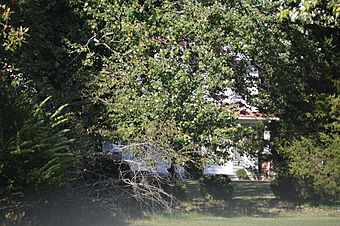Kippax Plantation facts for kids
|
Kippax Plantation Archeological Site
|
|

Southern portion of the plantation, with the current house visible
|
|
| Lua error in Module:Location_map at line 420: attempt to index field 'wikibase' (a nil value). | |
| Location | 999 Bland Ave, Hopewell, Virginia |
|---|---|
| Area | 9.3 acres (3.8 ha) |
| NRHP reference No. | 07000799 |
Quick facts for kids Significant dates |
|
| Added to NRHP | August 09, 2007 |
Kippax Plantation was an important historical site located in what is now Hopewell, Virginia. It was once the home of Colonel Robert Bolling (1646–1709) and his wife, Jane Rolfe. Jane was the granddaughter of the famous Native American woman Pocahontas and John Rolfe. Today, Kippax is a special archaeological site where experts are learning about life in early Virginia.
Contents
A Glimpse into Early Virginia Life
Kippax Plantation was built on the south bank of the Appomattox River in Virginia. It was the home of Colonel Robert Bolling. He married Jane Rolfe, who was a very important person in history. Her grandparents were Pocahontas and John Rolfe.
Robert and Jane had one child, John Bolling, who was born at Kippax in 1676. John later moved to a nearby place called Cobbs Plantation. While Jane's father, Thomas Rolfe, never lived at Kippax, it is believed that he was buried there. Robert and Jane Bolling are also thought to be buried at Kippax.
Uncovering History with Archaeology
Kippax Plantation is considered a very well-preserved archaeological site. This means that many old things are still buried there, waiting to be found. It is also well-documented, meaning there are good historical records about it.
In 2002, archaeologist Donald W. Linebaugh from the University of Kentucky found the remains of Colonel Bolling's house. This discovery helped experts understand where the main buildings of the plantation once stood.
What Archaeologists Are Finding
Most of the current digging at Kippax happens where the old house was found. Students from The College of William & Mary, led by Donald W. Linebaugh, have found traces of at least four different buildings. These buildings were used over many years, from the 1600s to the 1800s.
These discoveries can help answer big questions about early American history:
- How did early European settlers and Native Americans trade goods and interact?
- What were the daily lives like for the African American enslaved people who lived and worked there?
- How did different cultures mix and influence each other at the plantation?
Protecting the Kippax Site
The Kippax Plantation site is very important, so it needs to be protected. Recently, an organization called The Archaeological Conservancy bought the site. Their goal is to keep it safe from new buildings or other changes that could damage the historical remains.
The Conservancy is working to raise money to cover the cost of buying the land. By protecting Kippax, they ensure that future generations can continue to learn from this special place.

